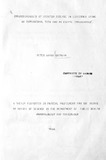| dc.description.abstract | A variety of methods based on immunological principles have been tried for the diagnosis of hydatid disease but largely with unsatisfactory results. One of the oldest illethods is the Casoni test which gives a reaction of immediate hypersensitivity when the antigen
is injected intradermally. This test, however, has not given the specificity nor the sensitivity required for a diagnostic test. Recent attempts to prepare a
defined Casoni antigen with higher specificity have resulted in a preparation which contains as its only in vitro - reactive immunological component the antigen
B of Oriol et al. (1971). In this study, a Casoni antigen was prepared by
boiling hydatid cyst fluid to inactivate most of the antigens and subsequent absorption using insoluble immunosorbents to remove any remaining undesirable
immunoreactive antigens. The final preparation was' shown on immunodiffusion and crossed immunoelectrophoretic analysis to contain only antigen B.
This was confirmed by the use of specific antisera.'
Determination of the molecular weight of antigen Busing Sephadex G-200 gel filtration indicated a major component with a molecular weight of approximately
180,000 daltons. Components of higher molecular weight were also noted but they were thought to be aggregates of the 180,000 dalton component. The detection of antigen B activity in fractions'of gel filtration was performed with an enzyme immunoassay and antiserum specific for antigen B as well as Casoni skin tests.
To elucidate if the Casoni antigen could elicit immediate hypersensitivity through non-immunoloqical means such as activation of the alternate complement pathway, various dilutions of tm preparation were injected intradermally in a normal rabbit which had received Evans Blue intravenously. The Casoni antigen dilutions gave insignificant reactions similar to those given by the injections of saline. When dilutions of antigen were injected intradermally in a sensitized goat, for the purpose of standardisation, distinct,and well delineated skin reactions were obtained. A dilution of the antigen was selected for use, as it was the highest dilution which gave distinct skin reactions which were only marginally smaller than the more concentrated dilutions. This preparation contained approximately 300~g protein per mI. Intradermal injections of 0.1ml thus cont3ined 30}Jg protein and was used to study the reaction in 135 goats of which 50 were found to have hydatid cysts at meat inspection, and in 64 cattle, of which 35 had hydatid cysts. The results were recorded as increases in skin thickness measured 30 minutes after tile intradermal injection. In the cattle population, animals with hydatidosis gave an increase in skin thickness ranging from O.7mm to 10.3mm with an average of 3.79mm,while the normal cattle gave reactions ranging from O.3mm to 3.5mm with an average of 1.98mm. The difference between the two means was found to be statistically (t-test) significant (P~O.05). When a 3mm increase in skin thickness was regarded as positive for hydatidosis: a specificity of 97% and a sensitivity of 57% were obtained. The results obtained with the goat population showed an almost complete overlap of skin reactivity between normal animals and animals with hydatidosis. The increase in skin thickness in the normal animals ranged from O.2mm to 4.7mm with an average of 2.47mm while in animals with hydatidosis the increase varied from O.3~m to 5.3mm. No significant difference was found between the means of normal animals and those with hydatidosis. It can therefore be concluded that the Casoni test might be useful under specified circumstances in cattle, while virtually incapable of distinguishing between infected and non-infected goats. These findings are largely in agreement with those of other research workers who have used the Casoni test in animal populations,• in spite of the use of a~ antigen preparatipn which, in vitro, showed the presence of only antigen B. It is possible that antigen B may not be the antigen which elicits the strongest and/or most specific immediate hypersensitivity reaction in animals and further investigations may be warranted to elucidate this. The unsatisfactory results with the use of a partly purified antigen preparatio~ in the Casoni test, prompted investigations into the use of the so called "Arc 5" antigen of Capron .§.i.3.l. (1967) also referred to as antigen A, of Oriol at ale (1971) in an enzyme immunoassay. This antigen had shown considerable promise for use in the serological diagnosis of hydatid disease in man,although experience with its use in the Turkana population has been disappointing. A specific antiserum against "Arc 5" antigen had already been prepared by injection of precipitin lines into goat No. 34~prepared by immunoelectrophoresis and later by immunodiffusion. The serum was absorbed for antibovine serum and anti sheep serum antibody activity. Absorption was also carried out with immunosorbents made from saline extracts of common intestinal parasites. Goat No. 346 IgG was used in the preparation of the conjuiate used in enzyme immunoassay. A total of 268 serum samples from cattle, of which 162 came from animals with hydatidosis, were titrated in an inhibition enzyme immunoassay designed to detect antibodies to "Arc 51! antigen only. Crude goat hydatid cyst fluid was used as antigen while goat No. 346 IgG - glucose oxidase_~~s the conjugate.
Reference curves for a known positive serum and a known negative ssrum were established. From the positive reference curve, the 50% inhibi~ion tit res for each test serum was calculated. The test gave a sensitivity of 56% and a specificity of 59% when a 50% inhibition titre of 8 was considered significanto When a 50% inhibition titre of_12 was considered significant, however, a sensitivity of 21% and a specificity of 99% were obtained. It is concluded that because of the low sensitivity and/or specificity obtained, the test is unsuitable for serodiagnosis or seroepidemiological surveys in cattle.
In this study, the Casoni test using a partially purified hydatid cyst fluid antigen and an enzyme immunoassay based on the detection of antibodies to "Arc 511 antigen yielded unsatisfactory results, and none of thase tests can therefore be recommended for the diagnosis of hydatid disease in livestock. | en |

